Yinka Shonibare’s striking and thought-provoking artwork ‘Refugee Astronaut’, on display in the recently opened ‘Being Human’ exhibition, embodies a complex message for modern times. The artist discusses the ideas behind it with Gwendolyn Smith.
Meet the climate emergency
Words by Gwendolyn Smithphotography by Thomas S G Farnetti
- Interview
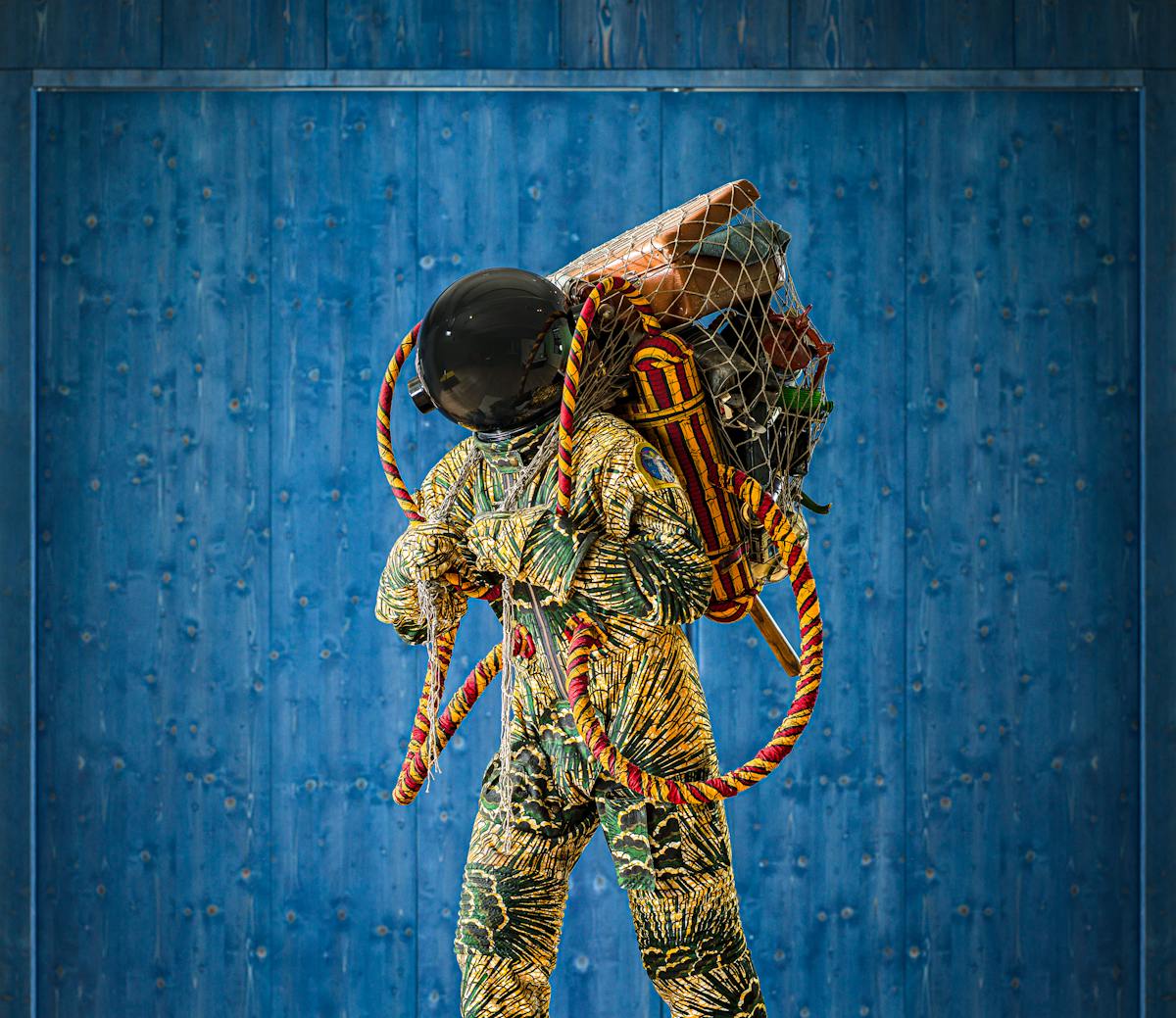
As concern about climate change rightfully crescendos, it is hard to see Yinka Shonibare’s ‘Refugee Astronaut’ as anything other than some sort of dire omen from an environmentally catastrophic future.
The life-size figure – the latest version of which is the flagship exhibit in Wellcome’s new permanent gallery ‘Being Human’ – is clad in moon boots, a spherical helmet and a spacesuit. The surrounding air seems to be too poisonous to inhale: the astronaut clutches a pair of breathing tubes attached to a tank on his or her back. Clearly, the traveller has upped sticks in a hurry: a tangle of possessions is hauled around in a ramshackle net.
“It is in one sense a warning,” says Shonibare. “It’s trying to imagine what could happen if we don’t do something about rising water levels and the displacement of people.”
The Turner Prize-shortlisted artist is known for exploring knotty themes, but he finds climate change a difficult subject to depict. “In general, the consequences are tangible but the process is intangible,” he says with a wry smile. This is also why it’s challenging to combat, he suggests.
“It’s not immediately graspable. That’s why things are very slow politically. People see they can still get their breakfast. It doesn’t feel urgent. Whereas if you’re in a war situation you can see your house being destroyed and that you have to respond very quickly.”
But urgent it is. Shonibare insists that the piece speaks to the present as well as the future, pointing out that the recent rise in asthma deaths has been linked to the air-pollution crisis.
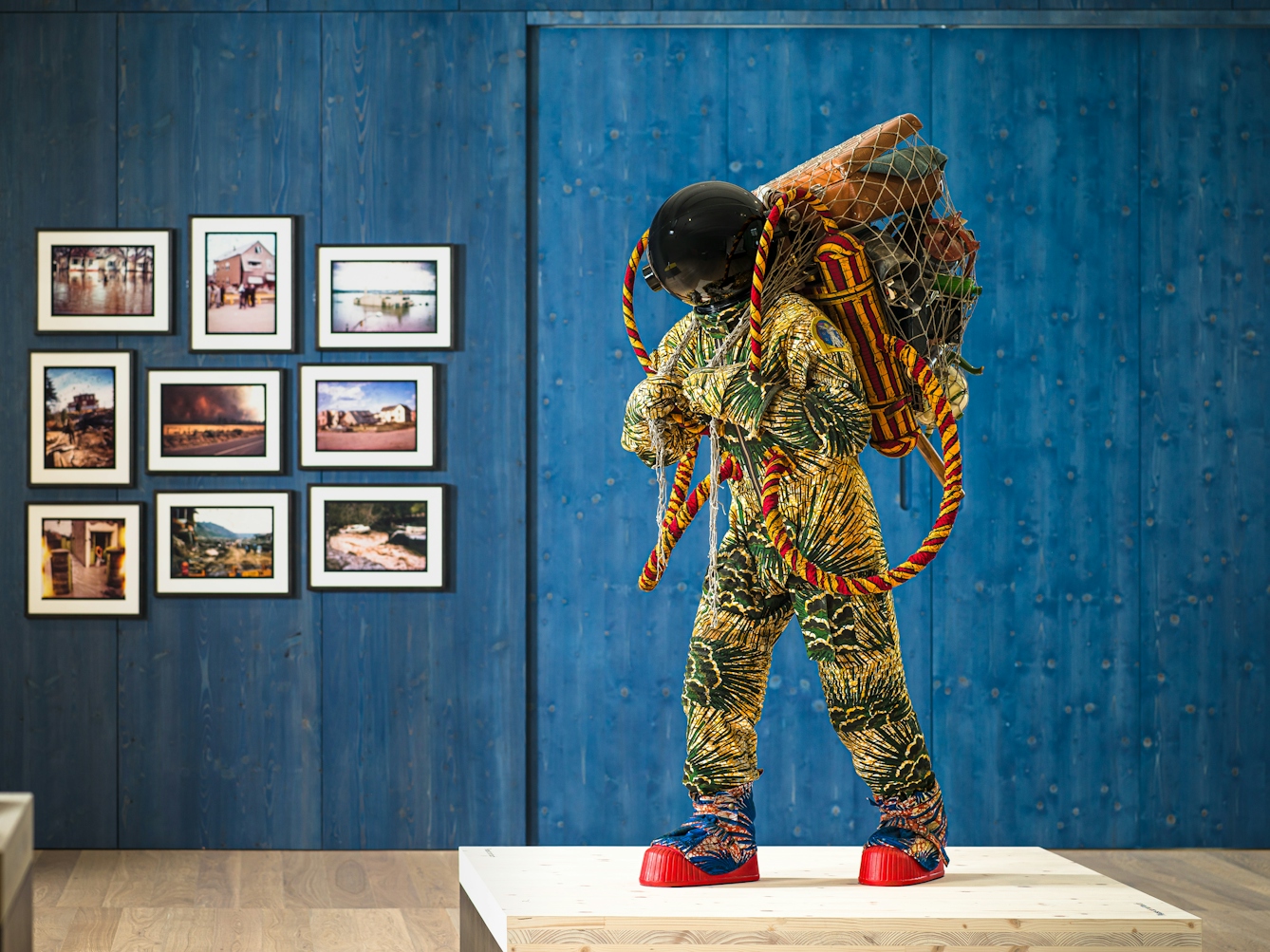
‘Refugee Astronaut’ in Wellcome’s new permanent gallery ‘Being Human’.
Capitalism’s toxic fallout
This is not just a vision of a post-apocalyptic dystopia, then, but a startling sideways look at today’s world. Governments are failing to treat the environment as an emergency, says Shonibare.
“Markets are still trading. And capitalism is still as strong as ever. Economics is based around the idea of growth, but we have finite resources. The two things can’t work together – you can’t have endless growth and no impact on the environment.” He shakes his head. “It’s still all about making as much money for your shareholders as you can.”
While ‘Refugee Astronaut’ is no doubt a striking response to environmental breakdown, it also throws up questions about race. Shonibare has long used Dutch wax fabrics to explore cultural heritage, and he employs the technique again here. Clothing the astronaut in fabric that is reminiscent of traditional Nigerian textiles subverts the notion of space exploration as a white endeavour, says Shonibare.
What you have here is a nomadic astronaut just trying to find somewhere that’s still habitable.
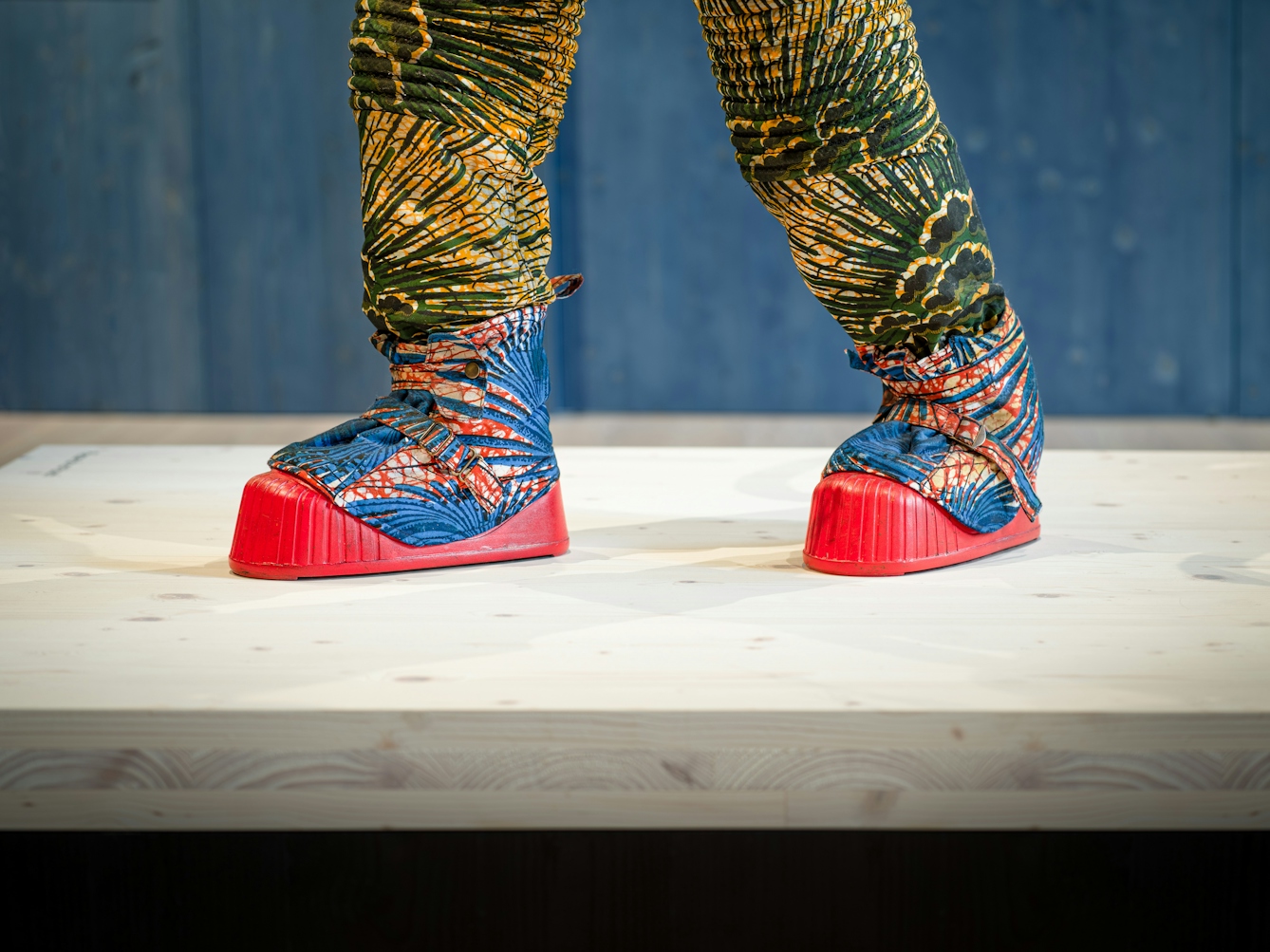
‘Refugee Astronaut’ wears moon boots.
It challenges colonial connotations, too. “The refugee astronaut is the reverse of the colonial instinct of the astronaut – someone who is going out to conquer the world. What you have here is a nomadic astronaut just trying to find somewhere that’s still habitable.”
In rendering the Everyman as a nomad, the piece also picks holes in the belief that certain people belong in certain places. “Nationalism is a very modern concept,” says Shonibare, adding that his long-held interest in the theme is partly a result of moving between London and Nigeria as a child. “Essentially we’re all nomads anyway, but people stake claim on places, which is a very modern idea – there’s nothing natural about that.”
While the idea of belonging might be an erroneous one, we should do our best to look after the places we’ve settled in. “With environmental degradation we may not have alternative places to go, we may just have to wear astronaut suits because” – he laughs grimly – “because basically we’ve messed it all up.”
In raising sometimes conflicting ideas about climate change, identity, colonialism and globalisation, ‘Refugee Astronaut’ is packed with Shonibare’s trademark ambiguities. “On the one hand it could be read as the participation of a diverse community in scientific discovery. The ethnic astronaut, if you like. But also it could be read as an apocalyptic vision. It could be a warning or it could be a celebration.”
In pictures
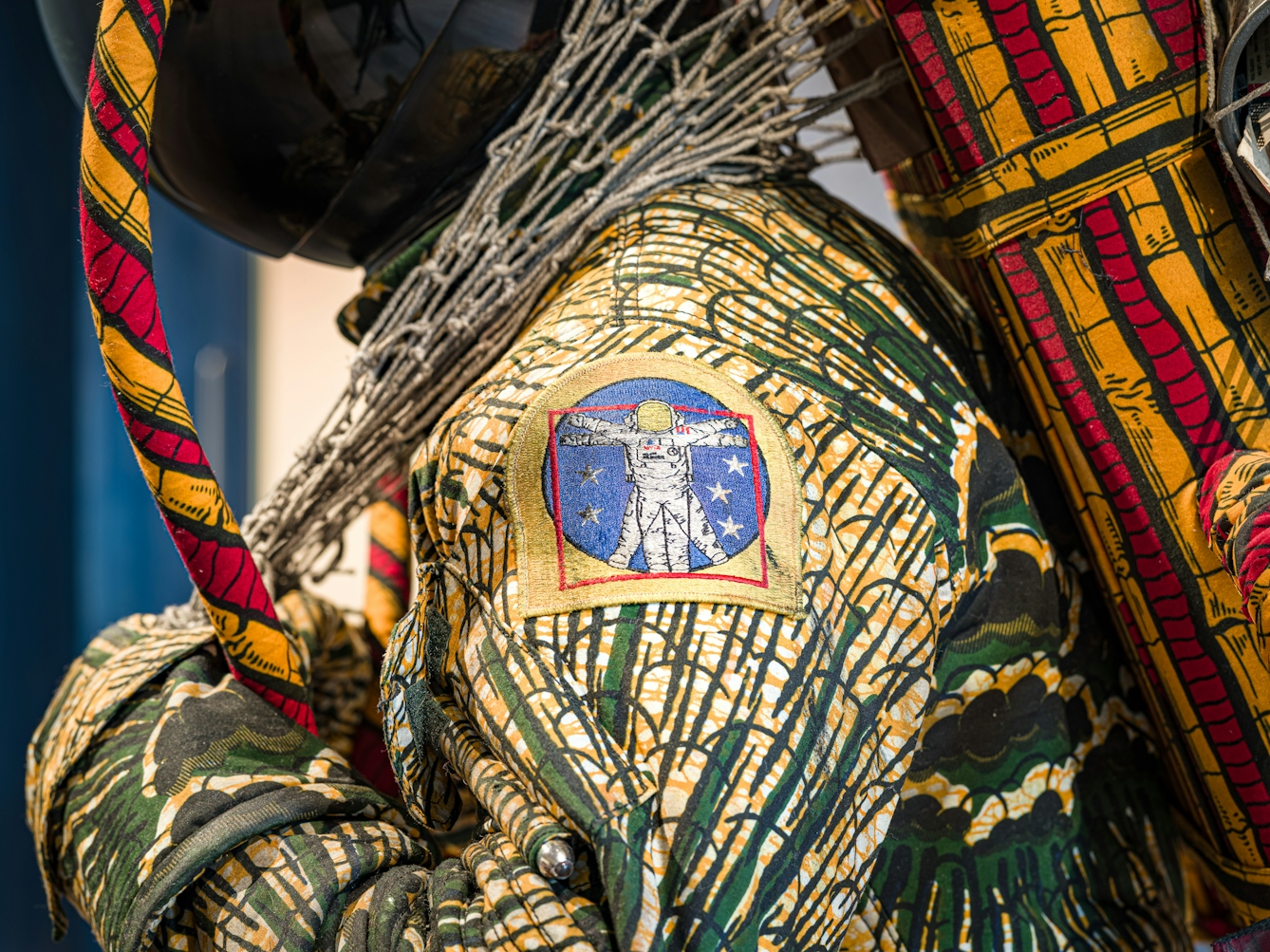
The astronaut shown on the figure’s shoulder badge is a reference to Leonardo da Vinci’s famous ‘Vitruvian Man’, which itself alludes to man’s relationship with the natural world.
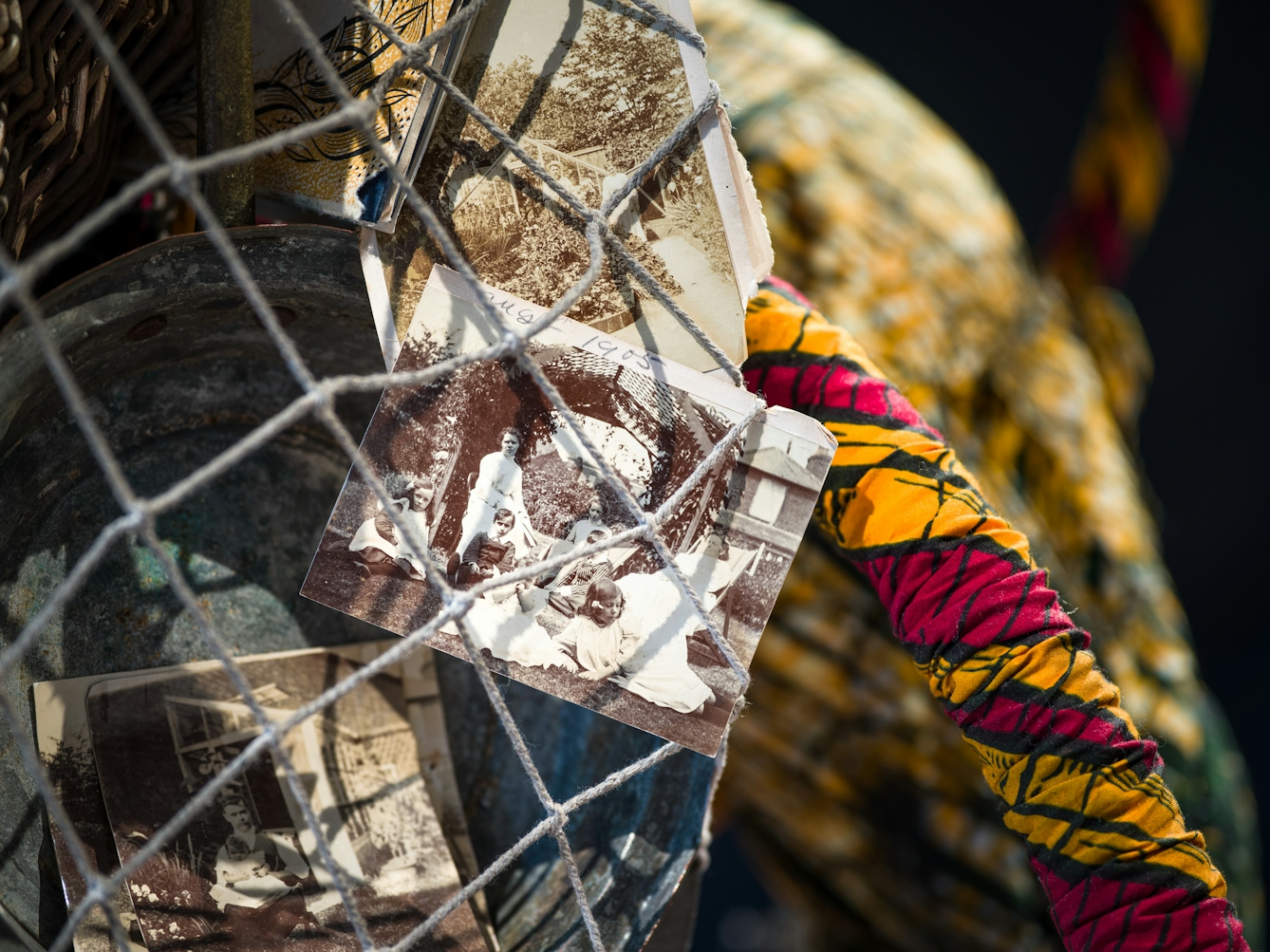
We keep photographs to help us remember the past. ‘Refugee Astronaut’ carries reminders of the early 20th century.
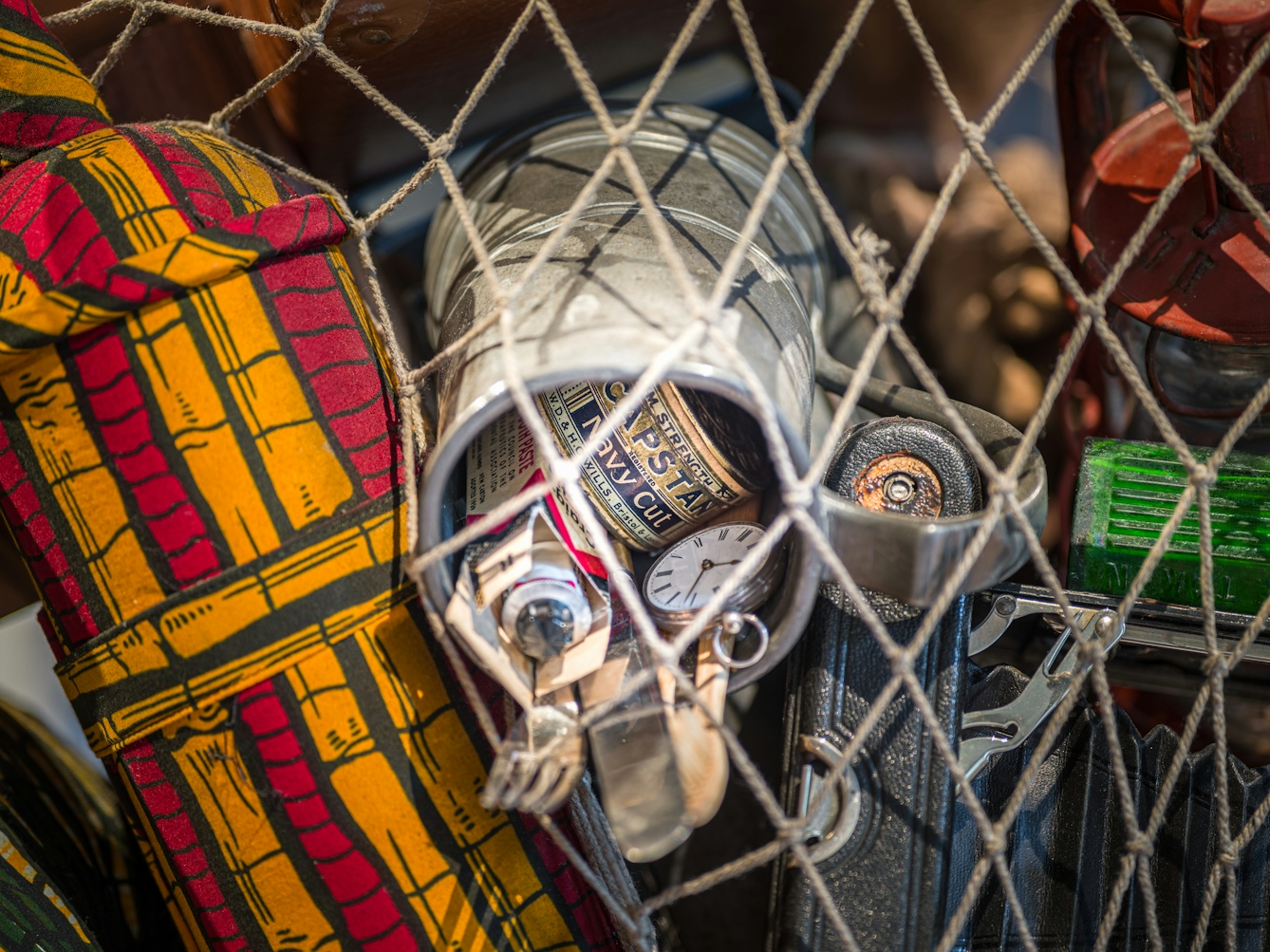
A pocket watch, tinned tobacco and a knife and fork.

Two books – ‘Captain Cook’s Voyages’ and a treatise on early 20th-century British politics – and a paraffin lamp.
Storytelling and emotion
He sees his work as a kind of “poetic storytelling”: “It’s up to the audience to think about the various implications, I guess.” As a technique, this can be more effective at changing minds than straight polemic, he says. “I don’t think people respond unless they have some kind of fiction. Cinema, theatre, art: with those things you’re appealing to people on an emotional level. You’re not just reading out statistics.”
That being said, has the increasingly toxic public discourse tempted him to take a firmer political stance? On the contrary, he shoots back immediately. “The current political climate has exposed the problems involved in such rigid positions and where they can lead to. People jump to conclusions very quickly and then it causes chaos.”
The ‘Being Human’ gallery is announced as Wellcome pledges to prioritise access, diversity and inclusion. Shonibare uses a wheelchair as a result of contracting transverse myelitis, an inflammation of the spinal cord that paralysed one side of his body, when he was eighteen. How accessible are galleries and museums in general, I ask?
“Galleries across London are very good. Public galleries. Not commercial galleries. Well, some commercial galleries are OK. The ones that have been renovated recently tend to be accessible, but if it’s a very old building you struggle. You can have ramps… they usually find some not-so-dignified way of getting into the buildings.” He gives a fluting chuckle.
Up next in his schedule is an exhibition at the Stephen Friedman Gallery in London of a Mappa Mundi-inspired series of quilts. It looks at the depiction of cultures that don’t share the white, Western background of the Mappa Mundi’s creators; figures are rendered without heads or with just one leg, for instance.
“The Mappa Mundi was a Google of its time because you could go and find out about the world while looking at it,” says Shonibare. “But the world view that they had was very… interesting.”
While Shonibare undercuts his politics with a slippery helping of poetry, does he want his art to change minds? He smiles. “I’m not deluded enough to think that people will see it and suddenly change their behaviour.” ‘Refugee Astronaut’ is just a succinct way of transmitting what science is already telling us about the state of the planet, he says. Nevertheless, he’s proud that work like his can provoke necessary conversations. “I want my art to make people think.”
About the contributors
Gwendolyn Smith
Gwendolyn Smith is a freelance culture journalist based in London.
Thomas S G Farnetti
Thomas is a London-based photographer working for Wellcome. He thrives when collaborating on projects and visual stories. He hails from Italy via the North East of England.

